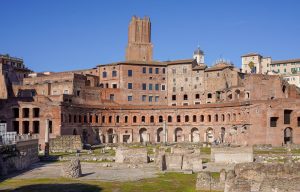Trajan’s Market (or the Markets of Trajan) is one of Rome’s most significant archaeological sites. Built around AD 110, it was intended to be a center of commerce and civic life. The market was built adjacent to the Forum of Trajan and surrounded by a two-story portico. On the upper level are offices, while on the lower level are shops and storerooms. The market was named for the Roman Emperor Trajan (reigned AD 98 – 117), who commissioned its construction. Today, the site is open to the public and houses a museum that showcases some of the artifacts that have been found at the site.
Construction
The Markets of Trajan was designed by the architect and engineer Apollodorus of Damascus, who also designed Trajan’s Forum, located just south of the market. It was completed and inaugurated around 113.
Historians consider it to be “the first shopping mall.” Trajan’s Market was built primarily from brick and concrete. The Romans were renowned for their cement known as opus caementicium, which was a long-lasting type of cement. It was durable and prevented cracks from spreading. The ruins of Nero’s Golden House (Domus Aurea), which was located nearby, were said to have been used to build the market’s foundations. Originally two stories high, four more stories were added years later during the Middle Ages.
Physical Description
The market is notable for its symmetrical and semi-circular design. It is a massive building, occupying an area of approximately 110 by 150 meters. It had six floors that were connected by terraces, an atrium, and a series of staircases. Trajan’s Market consists of a large central hall with an aisle on each side. The halls are covered by a groin vault (shaped by the perpendicular intersection of two barrel vaults), giving the feeling of an interior cavern. However, natural sunlight can still enter through the numerous windows. It has around 170 rooms in total. The lower levels were comprised of storerooms, and tabernae (single-room shops in Ancient Rome) used to sell fruits, vegetables, fish, oils, spices, and other goods, while the upper levels were home to residential apartments, administrative offices, and the library. A fire damaged the market but was promptly repaired in the early 3rd century. Today, the site is open to the public and houses a museum dedicated to the history of ancient Rome. It is situated on what is now the Via Dei Fori Imperiali, a road that runs from the Piazza Venezia to the Colosseum.
